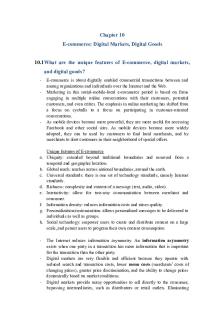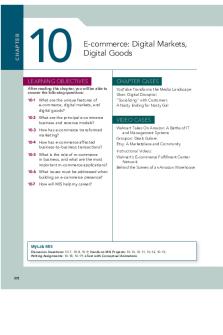Ch 10 E-commerce Digital Markets, Digital Goods PDF

| Title | Ch 10 E-commerce Digital Markets, Digital Goods |
|---|---|
| Author | Anita Eva |
| Course | Management Information System |
| Institution | Universitas Airlangga |
| Pages | 6 |
| File Size | 385.2 KB |
| File Type | |
| Total Downloads | 2 |
| Total Views | 137 |
Summary
Summary of chapter 10 about E-commerce...
Description
Chapter 10 E-commerce: Digital Markets, Digital Goods
10.1What are the unique features of E-commerce, digital markets, and digital goods? -
-
E-commerce is about digitally enabled commercial transactions between and among organizations and individuals over the Internet and the Web. Marketing in this social-mobile-local e-commerce period is based on firms engaging in multiple online conversations with their customers, potential customers, and even critics. The emphasis in online marketing has shifted from a focus on eyeballs to a focus on participating in customer-oriented conversations. As mobile devices become more powerful, they are more useful for accessing Facebook and other social sites. As mobile devices become more widely adopted, they can be used by customers to find local merchants, and by merchants to alert customers in their neighborhood of special offers.
Unique features of E-commerce a. Ubiquity: extended beyond traditional boundaries and removed from a temporal and geographic location. b. Global reach: reaches across national boundaries, around the earth. c. Universal standards: there is one set of technology standards, namely Internet standards. d. Richness: complexity and content of a message (text, audio, video). e. Interactivity: allow for two-way communication between merchant and consumer. f. Information density: reduces information costs and raises quality. g. Personalization/customization: allows personalized messages to be delivered to individuals as well as groups. h. Social technology: empower users to create and distribute content on a large scale, and permit users to program their own content consumption -
-
-
The Internet reduces information asymmetry. An information asymmetry exists when one party in a transaction has more information that is important for the transaction than the other party. Digital markets are very flexible and efficient because they operate with reduced search and transaction costs, lower menu costs (merchants’ costs of changing prices), greater price discrimination, and the ability to change prices dynamically based on market conditions. Digital markets provide many opportunities to sell directly to the consumer, bypassing intermediaries, such as distributors or retail outlets. Eliminating
intermediaries in the distribution channel (disintermediation) can significantly lower purchase transaction costs.
-
Digital goods are goods that can be delivered over a digital network. For the most part, digital goods are “intellectual property” which is defined as “works of the mind.”
10.2What are the principal e-commerce business and revenue models? Types of E-Commerce o Business-to-consumer: involves retailing products and services to individual shoppers. o Business-to-business: involves sales of goods and services among businesses. o Consumer-to-consumer: involves consumers selling directly to consumers. o M-commerce: the use of handheld wireless devices for purchasing goods and services from any location.
E-Commerce Business Models
E-
Commerce Revenue Models o Revenue model describes how the firm will earn revenue, generate profits, and produce a superior return on investment. o In the advertising revenue model, a Web site generates revenue by attracting a large audience of visitors who can then be exposed to advertisements. o In the sales revenue model, companies derive revenue by selling goods, information, or services to customers. o In the subscription revenue model, a Web site offering content or services charges a subscription fee for access to some or all of its offerings on an ongoing basis. o In the free/freemium revenue model, firms offer basic services or content for free, while charging a premium for advanced or special features. o In the transaction fee revenue model, a company receives a fee for enabling or executing a transaction. o In the affiliate revenue model, Web sites (called “affiliate Web sites”) send visitors to other Web sites in return for a referral fee or percentage of the revenue from any resulting sales.
10.3 How has e-commerce transformed marketing? The Internet provides marketers with new ways of identifying and communicating with millions of potential customers at costs far lower than traditional media, including search engine marketing, data mining, recommender systems, and targeted e-mail. The Internet allows marketers to inexpensively find potential customers for products where demand is very low. The Internet also provides new ways to gather information from customers, adjust product offerings, and increase customer value. Behavioral Targeting o Refers to tracking the clickstreams (history of clicking behavior) of individuals on thousands of Web sites for the purpose of understanding their interests and intentions, and exposing them to advertisements that are uniquely suited to their behavior. Social E-Commerce and Social Network Marketing o Social e-commerce is based on the mapping of all significant social relationships. o Social commerce uses social networks and social network sites to improve targeting of products and services. 10.4 How has e-commerce affected business-to-business transactions? Electronic Data Interchange (EDI) -
-
Electronic data interchange enables the computer-tocomputer exchange between two organizations of standard transactions such as invoices, bills of lading, shipment schedules, or purchase orders. Transactions are automatically transmitted from one information system to another through a network, eliminating the printing and handling of paper at one end and the inputting of data at the other.
New Ways of B2B Buying and Selling - Private industrial networks typically consist of a large firm using a secure Web site to link to its suppliers and other key business partners. - Net marketplaces, which are sometimes called e-hubs, provide a single, digital marketplace based on Internet technology for many different buyers and sellers. o Direct goods are goods used in a production process, such as sheet steel for auto body production. o Indirect goods are all other goods not directly involved in the production process, such as office supplies or products for maintenance and repair.
o Exchanges are independently owned third-party Net marketplaces that connect thousands of suppliers and buyers for spot purchasing.
10.5 What is the role of m-commerce in business, and what are the most important m-commerce applications? Location-Based Services and Applications -
Location-based services include geosocial services, geoadvertising, and geoinformation services. o A geosocial service can tell you where your friends are meeting. o Geoadvertising services can tell you where to find the nearest Italian restaurant, and geoinformation services can tell you the price of a house you are looking at, or about special exhibits at a museum you are passing.
Other Mobile Commerce Services - Banks and credit card companies are rolling out services that let customers manage their accounts from their mobile devices (JPMorgan Chase, Apple Pay, etc). - Google displaying ads to mobile phone linked to phone search engine (games, e-commerce, etc) - Shopkick mobile app that enables retailers to offer coupons (BestBuy, Macy’s, etc)
10.6 What issues must be addressed when building an e-commerce presence? The two most important management challenges in building a successful ecommerce presence are : (1) developing a clear understanding of your business objectives (2) knowing how to choose the right technology to achieve those objectives Develop E-Commerce Presence Map
Develop a Timeline : Milestones...
Similar Free PDFs

Ekonomi digital
- 4 Pages

Literacidad Digital
- 6 Pages

Digital Marketing
- 10 Pages

Digital Skill
- 35 Pages

Digital Binder
- 5 Pages

Sastra Digital
- 8 Pages

APLIKASI DIGITAL
- 4 Pages

Edicion digital
- 11 Pages

Digital Forensik
- 16 Pages

DIGITAL MARKETING
- 127 Pages

Elektronika Digital
- 19 Pages
Popular Institutions
- Tinajero National High School - Annex
- Politeknik Caltex Riau
- Yokohama City University
- SGT University
- University of Al-Qadisiyah
- Divine Word College of Vigan
- Techniek College Rotterdam
- Universidade de Santiago
- Universiti Teknologi MARA Cawangan Johor Kampus Pasir Gudang
- Poltekkes Kemenkes Yogyakarta
- Baguio City National High School
- Colegio san marcos
- preparatoria uno
- Centro de Bachillerato Tecnológico Industrial y de Servicios No. 107
- Dalian Maritime University
- Quang Trung Secondary School
- Colegio Tecnológico en Informática
- Corporación Regional de Educación Superior
- Grupo CEDVA
- Dar Al Uloom University
- Centro de Estudios Preuniversitarios de la Universidad Nacional de Ingeniería
- 上智大学
- Aakash International School, Nuna Majara
- San Felipe Neri Catholic School
- Kang Chiao International School - New Taipei City
- Misamis Occidental National High School
- Institución Educativa Escuela Normal Juan Ladrilleros
- Kolehiyo ng Pantukan
- Batanes State College
- Instituto Continental
- Sekolah Menengah Kejuruan Kesehatan Kaltara (Tarakan)
- Colegio de La Inmaculada Concepcion - Cebu




